Click on images to enlarge
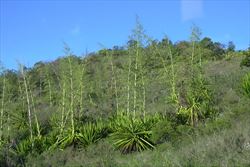
infestation (Photo: Forest and Kim Starr, USGS)
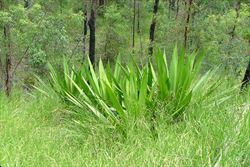
habit prior to flowering (Photo: Sheldon Navie)
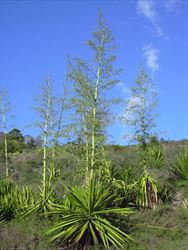
habit in flower (Photo: Forest and Kim Starr, USGS)
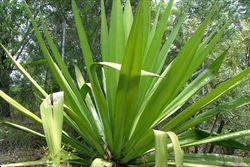
leaves (Photo: Sheldon Navie)

lower part of leaves showing some prickles (Photo: Sheldon Navie)
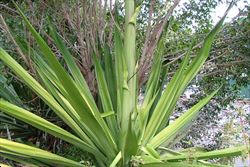
lower part of massive flowering stem (Photo: Sheldon Navie)
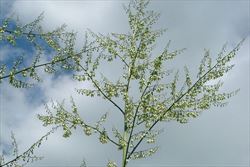
upper part of massive branched flower cluster (Photo: Sheldon Navie)
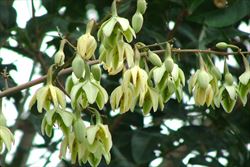
drooping flowers (Photo: Sheldon Navie)
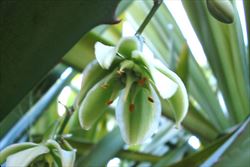
close-up of flower (Photo: Sheldon Navie)
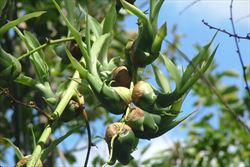
bulbils on old flowering stems (Photo: Sheldon Navie)
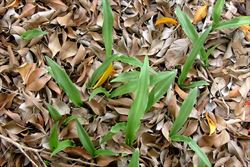
young plants (Photo: Sheldon Navie)
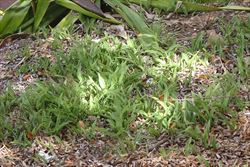
dense mass of young plants near adult plant (Photo: Sheldon Navie)
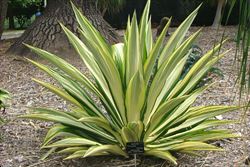
Furcraea foetida 'Mediopicta' (Photo: Sheldon Navie)
Scientific Name
Furcraea foetida (L.) Haw.
Synonyms
Agave foetida L.Agave gigantea D. Dietr.Furcraea gigantea Vent.
Family
Agavaceae
Common Names
Cuba hemp, Cuban hemp, false agave, giant false agave, giant cabuya, giant lily, green aloe, maguey, Mauritian hemp, Mauritius hemp, sisal
Origin
Native to the Caribbean (i.e. Guadeloupe and Martinique) and tropical South America (i.e. French Guiana, Guyana, Surinam, Brazil and Bolivia).
Cultivation
Mauritius hemp (Furcraea foetida) has been widely cultivated as a succulent garden ornamental. A cultivar with variegated leaves (i.e. Furcraea foetida 'Mediopicta') has become particularly popular in cultivation in recent years.
Naturalised Distribution
This species is commonly naturalised in the coastal districts of eastern Australia (i.e. in south-eastern and central Queensland and the coastal districts of central and northern New South Wales). It has also occasionally become naturalised in south-western Western Australia, on Lord Howe Island and on Norfolk Island.
Naturalised overseas in south-eastern USA (i.e. Florida), Hawaii, New Caledonia, Fiji, Niue, Tonga, La Réunion and New Zealand.
Habitat
A weed of urban bushland, open woodlands, roadsides, railways, embankments, cliffs, coastal environs, disturbed sites and waste areas in the warmer temperate and sub-tropical regions of Australia.
Habit
A fleshy (i.e. succulent) plant forming a large rosette of leaves up to 2 m tall and 2.5-3.5 m wide. It eventually produces a massive upright (i.e. erect) inflorescence 2-12 m in height.
Distinguishing Features
-
a large plant forming a cluster of fleshy leaves up to 2 m tall and 2.5-3.5 m wide.
- these very large elongated leaves (up to 2.5 m long and 20 cm wide) have a sharp brown spine (4-8 cm long) at the tip.
-
they also have some widely-spaced prickles (4-10 mm long) along their lower margins.
-
it eventually produces a massive upright, and much-branched, flower cluster (2-12 m tall).
-
its drooping flowers (3.5-4 cm long and 4-4.5 cm across) are greenish-white or yellowish-green and have six 'petals'.
-
it produces numerous large plantlets (1-16 cm long) on the branches of the old flower clusters.
Stems and Leaves
The main stem or trunk at the base of the plant is quite short (i.e. less than 1 m tall and often only 20-30 cm tall) and is usually hidden below the leaves. The large flowering stems are green, hairless (i.e. glabrous), and very robust.
The very large fleshy (i.e. succulent) leaves are arranged in a rosette and are elongated in shape (i.e. linear-lanceolate to oblanceolate). These rigid leaves (1.2-2.5 m long and 7-20 cm wide on adult plants) are mostly entire, but usually have some widely-spaced hooked prickles (4-10 mm long) along their lower margins. They are pale green or bright green in colour, somewhat glossy in appearance, and are gradually narrowed to a sharp brown spine (4-8 cm long) at the tip (i.e. apical spine). Smaller leaves are also alternately arranged along the base of the flowering stem.
Flowers and Fruit
The numerous flowers are borne in a very large branched cluster (1-6 m long) towards the top of the massive flowering stem (i.e. in a terminal panicle). These flowers (3.5-4 cm long and 4-4.5 cm across) are greenish-white or yellowish-green in colour. They are drooping in nature (i.e. pendent) and borne on stalks (i.e. pedicels) 3-5 cm long. Each flower has six 'petals' (i.e. perianth segments or tepals) that are fused together at the base. These 'petals' (2.5-3.3 cm long and 1-1.8 cm wide) are mostly white on the outside and greenish-white or yellowish-green on the inside. They have six stamens with yellow anthers borne on stalks (i.e. filaments) about 10 mm long, with these stalks being swollen in the lower half. They also have an ovary (5-15 mm long) topped with a style (about 10 mm long) and a three-lobed stigma. The flowers are heavily fragrant and are produced during autumn and winter. Flowering usually only occurs once, with the whole plant dying about 1 year after the onset of flowering.
Fruit are generally not produced. What might appear to be fruit are actually large plantlets (i.e. bulbils) 1-16 cm long. The true fruit, which are rarely if ever seen in Australia, are large capsules up to 8 cm long and contain numerous black, flattened, seeds.
Reproduction and Dispersal
This species reproduces by plantlets (i.e. bulbils), which are formed by the thousands on the branches of the massive flower clusters.
Gravity is the main natural means of dispersal, and dense thickets often form around individual plants. These plantlets may also be spread larger distances by animals, in soil, or in dumped garden waste.
Environmental Impact
Mauritius hemp (Furcraea foetida) is regarded as an environmental weed in Western Australia and Queensland. It is known to invade coastal sites and cliffs, gullies, hillsides and open woodlands where it crowds out native species. It is most widespread and problematic in south-eastern Queensland, where it is ranked among the top 200 environmental weeds.
Mauritius hemp (Furcraea foetida) is occasionally naturalised in bushland around the foreshores of Sydney Harbour, particularly in Mosman, and is present at Brunswick Heads on the New South Wales North Coast. Infestations have also been recorded in conservation areas on the south coast of New South Wales (i.e. Eurobodalla National Park and Murramarang National Park). In south-western Western Australia, Mauritius hemp (Furcraea foetida ) has become naturalised in disturbed heath and in Kings Park in suburban Perth. It is also listed as an invasive plant that is targeted for eradication in the Lord Howe Island Biodiversity Management Plan.
In Hawaii, Mauritius hemp (Furcraea foetida ) is often locally abundant in dry to moderately moist disturbed sites (e.g. on slopes, rocky ledges, and in pastures) and it is extensively naturalised on Niue. In New Zealand it is considered to have a significant effect on indigenous communities, though it does not spread quickly.
Legislation
Not declared or considered noxious by any state government authorities.
Similar Species
Cuban hemp (Furcraea foetida) is very similar to variegated false agave (Furcraea selloa) and relatively similar to century plant (Agave americana), Caribbean agave (Agave angustifolia) and the sisals (Agave sisalana and Agave vivipara). These species can be distinguished by the following differences:
- Mauritius hemp (Furcraea foetida) has pale green leaves without any prickles or with some widely-spaced prickles only along their lower margins. Its whitish-green coloured flowers are borne in a drooping position and have relatively short stamens (about 1 cm long). It usually does not produce fruit, instead developing large numbers of plantlets (i.e. bulbils).
- false agave (Furcraea selloa) has variegated leaves with pale green centres and whitish coloured margins. They have prickles all along their margins. Its whitish-green flowers are borne in a drooping position and have relatively short stamens (about 1 cm long). It usually does not produce fruit, instead developing large numbers of plantlets (i.e. bulbils).
- century plant (Agave americana) has grey, greyish-green or variegated leaves with prickles all along their margins. Its greenish-yellow flowers are borne in an upright position and have very long stamens (6-10 cm long). It produces large capsules (4-6 cm long), but rarely develops plantlets (i.e. bulbils).
- Caribbean agave (Agave angustifolia) has relatively large green, greyish-green or variegated leaves that are usually 0.5-1 m long on adult plants. These leaves have many, relatively small prickles (2-5 mm long) along their margins. Its flowers are borne in an upright position and are yellow or yellowish-green in colour. This species produces large capsules and sometimes also develops plantlets (i.e. bulbils) on the branches of its flower clusters.
- sisal (Agave sisalana) has greyish-green or dark green leaves without any prickles along their margins. Its greenish-yellow flowers are borne in an upright position and have relatively long stamens (5-6 cm long). It produces large capsules (about 6 cm long), and often also plantlets (i.e. bulbils).
- sisal (Agave vivipara) has greyish-green or dark green leaves with prickles all along their margins. Its greenish-yellow flowers are borne in an upright position and have relatively long stamens (3.5-4.5 cm long). It produces large capsules (about 5 cm long), and often also plantlets (i.e. bulbils).
Young Mauritius hemp (Furcraea foetida) plants are also similar to the river lily (Crinum pedunculatum), giant spear lily (Doryanthes palmeri) and Gymea lily (Doryanthes excelsa), which are all native to eastern Australia. However, the river lily (Crinum pedunculatum) does not have spines on the tips of its leaves and usually grows in wetter habitats. Giant spear lily (Doryanthes palmeri) and Gymea lily (Doryanthes excelsa) leaves are not fleshy and their flowers are bright red.

